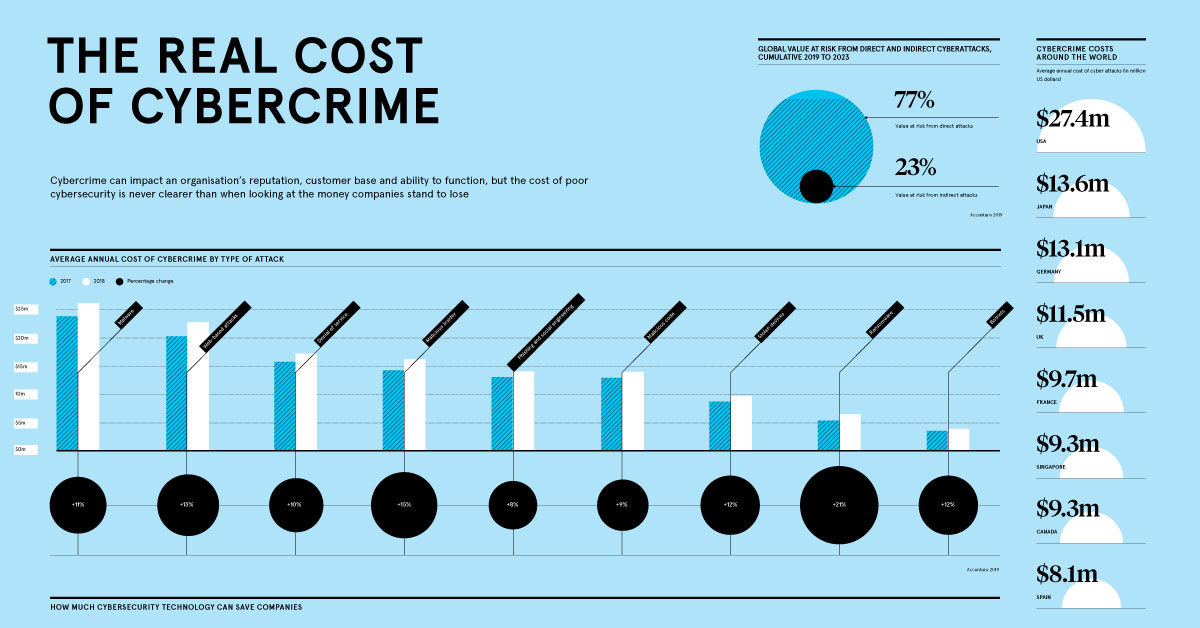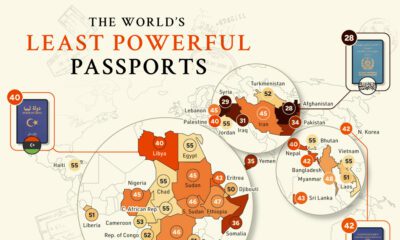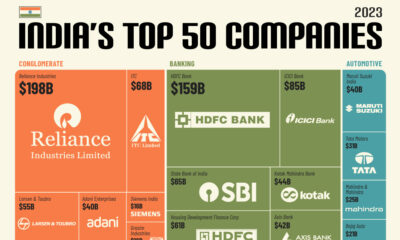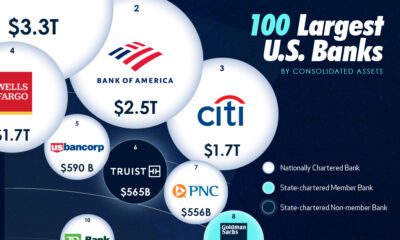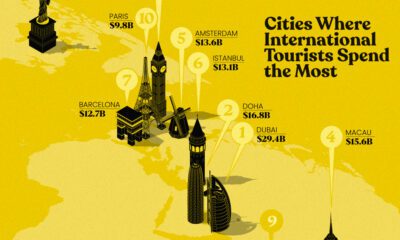Technology
Visualizing the Massive Cost of Cybercrime
View the full-size version of this infographic.
Visualizing the Massive Cost of Cybercrime
View the high resolution of this infographic by clicking here.
What do Equifax, Yahoo, and the U.S. military have in common? They’ve all fallen victim to a cyberattack at some point in the last decade—and they’re just the tip of the iceberg.
Today’s infographic from Raconteur delves into the average damage caused by cyberattacks at the organizational level, sorted by type of attack, industry, and country.
Rising Cybercrime Costs Across the Board
The infographic focuses on data from the latest Accenture “Cost of Cybercrime” study, which details how cyber threats are evolving in a fast-paced digital landscape.
Overall, the average annual cost to organizations has been ballooning for all types of cyberattacks. For example, a single malware attack in 2018 costed more than $2.6 million, while ransomware costs rose the most between 2017–2018, from $533,000 to $646,000 (a 21% increase).
Both information loss and business disruption occurring from attacks have been found to be the major cost drivers, regardless of the type of attack:
- Malware
Major consequence: Information Loss
Average cost: $1.4M (54% of total losses) - Web-based attacks
Major consequence: Information Loss
Average cost: $1.4M (61% of total losses) - Denial-of-Service (DOS)
Major consequence: Business Disruption
Average cost: $1.1M (65% of total losses) - Malicious insiders
Major consequences: Business Disruption and Information Loss
Average cost: $1.2M ($0.6M each, 75% of total losses)
In 2018, information loss and business disruption combined for over 75% of total business losses from cybercrime.
Cybercrime Casts a Wide Net
No industry is untouched by the growing cost of cybercrime—the report notes that organizations have seen security breaches grow by 67% in the past five years alone. Banking is the most affected, with annual costs crossing $18 million in 2018. This probably comes as no surprise, considering that financial motives are consistently a major incentive for hackers.
Here is the average cost of cyberattacks (per organization) across 15 different industries:
| Industry | 2017 Cost | 2018 Cost | % Change |
|---|---|---|---|
| Banking | $16.6M | $18.4M | +11% |
| Utilities | $15.1M | $17.8M | +18% |
| Software | $14.5M | $16M | +11% |
| Automotive | $10.7M | $15.8M | +47% |
| Insurance | $12.9M | $15.8M | +22% |
| High tech | $12.9M | $14.7M | +14% |
| Capital markets | $10.6M | $13.9M | +32% |
| Energy | $13.2M | $13.8M | +4% |
| U.S. Federal | $10.4M | $13.7M | +32% |
| Consumer goods | $8.1M | $11.9M | +47% |
| Health | $12.9M | $11.8M | -8% |
| Retail | $9M | $11.4M | +26% |
| Life sciences | $5.9M | $10.9M | +86% |
| Media | $7.6M | $9.2M | +22% |
| Travel | $4.6M | $8.2M | +77% |
| Public sector | $6.6M | $7.9M | +20% |
Interestingly, the impact on life sciences companies rose the most in a year (up by 86% to $10.9 million per organization), followed by the travel industry (up 77% to $8.2 million per organization). This is likely due to an increase in sensitive and valuable data being shared online, such as clinical trial details or credit card information.
So What Can Companies Do?
Accenture analyzed nine cutting-edge technologies that are helping mitigate cybercrime, and calculated their net savings: the total potential savings minus the required investment in each type of technology or tool.
With almost $2.3 million in net savings, many companies recognize the high payoff that comes with security intelligence. On the other hand, leveraging automation, artificial intelligence, and machine learning can potentially save over $2 million—however, only 38% of businesses have adopted this solution so far.
Cybercrime will remain a large-scale concern for years to come. From 2019–2023E, approximately $5.2 trillion in global value will be at risk from cyberattacks, creating an ongoing challenge for corporations and investors alike.
Brands
How Tech Logos Have Evolved Over Time
From complete overhauls to more subtle tweaks, these tech logos have had quite a journey. Featuring: Google, Apple, and more.

How Tech Logos Have Evolved Over Time
This was originally posted on our Voronoi app. Download the app for free on iOS or Android and discover incredible data-driven charts from a variety of trusted sources.
One would be hard-pressed to find a company that has never changed its logo. Granted, some brands—like Rolex, IBM, and Coca-Cola—tend to just have more minimalistic updates. But other companies undergo an entire identity change, thus necessitating a full overhaul.
In this graphic, we visualized the evolution of prominent tech companies’ logos over time. All of these brands ranked highly in a Q1 2024 YouGov study of America’s most famous tech brands. The logo changes are sourced from 1000logos.net.
How Many Times Has Google Changed Its Logo?
Google and Facebook share a 98% fame rating according to YouGov. But while Facebook’s rise was captured in The Social Network (2010), Google’s history tends to be a little less lionized in popular culture.
For example, Google was initially called “Backrub” because it analyzed “back links” to understand how important a website was. Since its founding, Google has undergone eight logo changes, finally settling on its current one in 2015.
| Company | Number of Logo Changes |
|---|---|
| 8 | |
| HP | 8 |
| Amazon | 6 |
| Microsoft | 6 |
| Samsung | 6 |
| Apple | 5* |
Note: *Includes color changes. Source: 1000Logos.net
Another fun origin story is Microsoft, which started off as Traf-O-Data, a traffic counter reading company that generated reports for traffic engineers. By 1975, the company was renamed. But it wasn’t until 2012 that Microsoft put the iconic Windows logo—still the most popular desktop operating system—alongside its name.
And then there’s Samsung, which started as a grocery trading store in 1938. Its pivot to electronics started in the 1970s with black and white television sets. For 55 years, the company kept some form of stars from its first logo, until 1993, when the iconic encircled blue Samsung logo debuted.
Finally, Apple’s first logo in 1976 featured Isaac Newton reading under a tree—moments before an apple fell on his head. Two years later, the iconic bitten apple logo would be designed at Steve Jobs’ behest, and it would take another two decades for it to go monochrome.
-

 Green1 week ago
Green1 week agoRanked: The Countries With the Most Air Pollution in 2023
-

 Automotive2 weeks ago
Automotive2 weeks agoAlmost Every EV Stock is Down After Q1 2024
-

 AI2 weeks ago
AI2 weeks agoThe Stock Performance of U.S. Chipmakers So Far in 2024
-

 Markets2 weeks ago
Markets2 weeks agoCharted: Big Four Market Share by S&P 500 Audits
-

 Real Estate2 weeks ago
Real Estate2 weeks agoRanked: The Most Valuable Housing Markets in America
-

 Money2 weeks ago
Money2 weeks agoWhich States Have the Highest Minimum Wage in America?
-

 AI2 weeks ago
AI2 weeks agoRanked: Semiconductor Companies by Industry Revenue Share
-

 Travel2 weeks ago
Travel2 weeks agoRanked: The World’s Top Flight Routes, by Revenue

